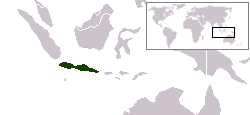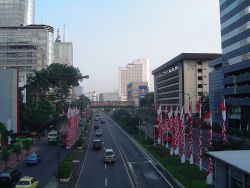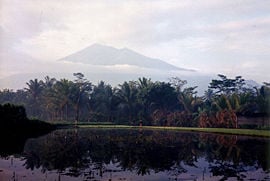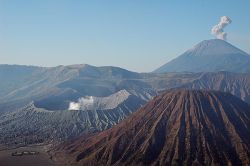Java
| Native name: Pulau Jawa | |
 Location of Java | |
| Geography | |
|---|---|
| Location | Southeast Asia |
| Coordinates | {{#invoke:Coordinates|coord}}{{#coordinates:7|30|10|S|111|15|47|E|type:isle_region:ID_scale:8100000
| |name= }} |
| Archipelago | Greater Sunda Islands |
| Area | 126,700 km² (~48,900 sq. mi.) (about the size of the state of Mississippi, USA, or about one-third the size of Germany) |
| Highest point | Semeru (3,676 m) |
| Country | |
| Provinces | Banten, Jakarta Special Capital City District, West Java, Central Java, East Java, Yogyakarta Special Region |
| Largest city | Jakarta |
| Demographics | |
| Population | 124 million (as of 2005) |
| Density | 979/km² people/km2 |
| Ethnic groups | Sundanese, Javanese, Tenggerese |
Java (Indonesian, Javanese, and Sundanese: Jawa) is an island of Indonesia and the site of its capital city, Jakarta. Once the centre of powerful Hindu kingdoms and the core of the colonial Dutch East Indies, Java now plays a dominant role in the economic and political life of Indonesia. With a population of 124 million, it is the most populous island in the world; it is also one of the most densely populated regions on Earth.
Formed mostly as the result of volcanic events, Java is the 13th largest island in the world and the fifth largest island of Indonesia. A chain of volcanic mountains form an east-west spine along the island. It has three main languages, and most residents are bilingual, with Indonesian as their second language. While the majority of Javanese are Muslim, Java has a diverse mixture of religious beliefs and cultures.
Etymology
The origins of the name 'Java' is not clear. One possibility is early travellers from India named the island after the jáwa-wut plant, which was said to be common in the island during the time, and that prior to Indianization the island had different names.[1] There are other possible sources: the word jaú and its variations mean "beyond" or "distant".[2] And, in Sanskrit yava means barley, a plant for which the island was famous.[3]
Outsiders often referred to Java and the neighboring islands by the same name, or use names inconsistently for different islands. For example, Marco Polo refers to neighbouring Sumatra as "little Java"[4] and Ptolemy refers Sumatra as Jaba-diu.[5]
History
Pre-history
The island of Java is known for several important finds of early hominid specimens [6]. In particular, the 1891 discovery of cranial fossil remains commonly known as "Java man" (now designated as Trinil 2, after the Trinil site on the Bengawan Solo River) is notable as the first early hominid specimen found outside Europe. This find, and several subsequent ones at various locations along the river's valleys, are now generally classified in the species Homo erectus.
Scientists speculate that, two million years ago, heavy rainfall in the Sunda and Digul plateaus produced dense tropical vegetation, which supported the prehistoric hominids evidenced in many fossil finds.
Hindu and Buddhist kingdoms
Much evidence of Java's past kingdoms remains; such as the famous Buddhist Borobudur and Hindu Prambanan temples. Indeed, the Javanese culture, and language itself, was heavily influenced by the cultures and languages of the Indian subcontinent. In the sixth and seventh centuries, many maritime kingdoms arose in Sumatra and Java, which controlled the waters in the Straits of Malacca, and flourished with the increasing sea-trade between China and India and beyond. During this time, scholars from India and China visited these kingdoms to translate literary and religious texts. The most influential of these kingdoms was Srivijaya.
The most prominent of the Hindu kingdoms was the Majapahit empire based in East Java, from where it held sway over a large part of what is now Indonesia. The name of the Majapahit empire is still invoked by contemporary Indonesian leaders to promote "unity", and the legitimacy of the state. The remnants of the Majapahit's priests, royalties, and artisans, fled to Bali during the sixteenth century, as Muslim kingdoms in the coastal part of the island gained influence.
Muslim kingdoms and the Dutch colonization
The earliest Muslim "evangelists" were called the Wali Songo, the "nine ambassadors". Several of them were of Chinese origin, leading to speculation about Zheng He's influence on the trade in the Straits of Malacca. Many of their tombs are still well-preserved, and often visited "Ziarah" for superstitious and religious reasons. Most of the brand of Islam that is adopted in Java is mixed with long-standing indigenous beliefs, and has a decidedly "local flavor". For example, the legend of Nyi Roro Kidul was invented as a mix of the beliefs common on the southern coast of Java, and Islamic influences.
The Dutch East India Company (VOC) established its trading and administrative headquarters in Batavia (now the capital city of Jakarta). This capital, along with other coastal cities such as Semarang and Surabaya, was the focus of Dutch attention during most of the colonial period. The VOC maintained control over the mountainous interior of the island through indigenous client states, such as Mataram in central Java.
The nineteenth century saw the Dutch government take over administration of Indonesia from the VOC, and in the mid-nineteenth century, they implemented new policies, usually called the Culture System (Dutch: cultuurstelsel). These policies, intended to increase the profitability of the colony by requiring increased production of cash crops, led to famine and widespread poverty on Java. By the beginning of the twentieth century, protest over the policy's effects, and political changes in the Netherlands and in the Indies led to the Ethical Policy. This policy of increased investment in the colony gave many more Javanese elites access to a Dutch education, both in Java and in the Netherlands itself. It was from this elite that the most prominent nationalist leaders came. They formed the core of the new government, when Indonesia became a Republic after World War II.
Republican era
With the establishment of Jakarta as the capital and the Javanese roots of the majority of Indonesian political figures, the island has a dominant role in the political and economic life of the nation. While parts of rural Java are among the poorest in the nation, the urban areas of the island are Indonesia's wealthiest and most urbanized areas. Presidents Sukarno (1945–1965), Suharto (1965–1998), Abdurrahman Wahid a.k.a GusDur (1999–2001), Megawati Sukarnoputri (2001–2004), and Susilo Bambang Yudhoyono (2004-now) were all from Java. The only president who was not from Java was Baharuddin Jusuf Habibie (1998–1999).
This political dominance has resulted in resentment on the part of some residents of other islands. Indonesian author Pramoedya Ananta Toer once recommended that the Indonesian capital be moved outside the island of Java, in order to free the Indonesian nationalist movement from its Java-centric character.
Geography
Java () [7] is part of the Sunda Island Arc, which includes Sumatra to the northwest and Bali to the east. Borneo lies to the north and Christmas Island to the south. It is the world's 13th largest island.
Java is almost entirely of volcanic origin; it contains no fewer than thirty-eight mountains forming an east-west spine which have at one time or another been active volcanoes. The highest volcano in Java is Mount Semeru (3,676 m). The most active volcano in Java and also in Indonesia is Mount Merapi (2,914 m). See Volcanoes of Java. Further mountains and highlands help to split the interior into a series of relatively isolated regions suitable for wet-rice cultivation; the rice lands of Java are among the richest in the world.[8]
The island's longest river is the 600 km long Bengawan Solo River.[9] The river rises from its source in central Java at the Tawu volcano, flows north then eastwards to its mouth in the Java Sea, near the city of Surabaya.
The island is administratively divided into four provinces (Banten, West Java, Central Java, and East Java), one special region (Yogyakarta), and one special capital district (Jakarta).
Popular tourist destinations include the city of Yogyakarta, the huge Buddhist stupa complex of Borobudur, the Hindu temples at Prambanan, and Mount Bromo in East Java.
Demographics

Java is by far the most populous island in Indonesia, with approximately 62% of the country's population,[10] and is the most populous island in the world. With 130 million inhabitants at 940 people per km², it is also one of the most densely-populated parts of the world. If it were a country, it would be the second-most densely-populated country of the world after Bangladesh, if very small city-states are excluded.[11] Approximately 45% of the population of Indonesia is ethnically Javanese.[12]
Since the 1970s, the Indonesian government has run transmigration programs aimed at resettling the population of Java on other less-populated islands of Indonesia. This program has met with mixed results, and sometimes caused conflicts between the locals and the recently arrived settlers.
Culture
Generally speaking, the three major cultures of Java are the Sundanese culture of West Java, the Central Javanese culture, and the Eastern Javanese culture. In the southwestern part of Central Java, usually named the Banyumasan region, a cultural mingling occurred; bringing together Javanese culture and Sundanese culture to create the Banyumasan culture.
In the central Javanese court cities of Yogyakarta and Surakarta, contemporary kings trace their lineages back to the pre-colonial Islamic kingdoms that ruled the region, making those places especially strong repositories of classical Javanese culture. Classic arts of Java include gamelan music and wayang puppet shows.
Java was the site of many influential kingdoms in the Southeast Asian region, and as a result, many literary works have been written by Javanese authors. These include Ken Arok and Ken Dedes, the story of the orphan who usurped his king, and married the queen of the ancient Javanese kingdom; and translations of Ramayana and Mahabarata. Pramoedya Ananta Toer is a famous contemporary Indonesian author, who has written many stories based on his own experiences of having grown up in Java, and takes many elements from Javanese folklore and historical legends.
See also: Culture of Indonesia
Languages
The three major languages spoken on Java are Javanese, Sundanese and Madurese. Other languages spoken include Betawi (a Malay dialect local to the Jakarta region), Osing and Tenggerese (closely related to Javanese), Badui (closely related to Sundanese), Kangeanese (closely related to Madurese), and Balinese.[13] The vast majority of the population also speaks Indonesian, generally as a second language.
Religion
More than 90 percent of Javanese are Muslims, on a broad continuum between abangan (more nominal or syncretic) and santri (more orthodox). Small Hindu enclaves are scattered throughout Java, but there is a large Hindu population along the eastern coast nearest Bali, especially around the town of Banyuwangi. There are also Christian communities, mostly in the larger cities, though some rural areas of south-central Java are strongly Roman Catholic. Buddhist communities also exist in the major cities, primarily among the Chinese Indonesian. The Indonesian constitution recognises six official religions. (See Religion in Indonesia.)
Java has been a melting pot of religions and cultures, which has created a broad range of religious belief. Indian influences came first with Shivaism and Buddhism penetrating deeply into society, blending with indigenous tradition and culture.[14] One conduit for this were the ascetics, called resi, who taught mystical practices. A resi lived surrounded by students, who took care of their master's daily needs. Resi's authorities was merely ceremonial. At the courts, Brahmin clerics and pudjangga (sacred literati) legitimised rulers and linked Hindu cosmology to their political needs.[14]
Islam, which came after Hinduism, strengthened the status structure of this traditional religious pattern. The Muslim scholar of the writ (kyai) became the new religious elite as Hindu influences receded. Islam recognises no hierarchy of religious leaders nor a formal priesthood, but the Dutch colonial government established an elaborate rank order for mosque and other Islamic preaching schools. In Javanese Islamic schools (pesantren), kyai prepertuated the tradition of resi. Students around him provided his needs, even peasants around the school.[14]
Pre-Islamic Javanese traditions have encouraged Islam in a mystical direction. There emerged in Java a loosely structured society of religious leadership, revolving around kyais, possessing various degrees of proficiency in pre-Islamic and Islamic lore, dogma and practice.[14] The kyais are the principal intermediaries between the villages masses and the realm of the supernatural. However, this very looseneess of kyai leadership structure has promoted schism. There were often sharp divisions between orthodox kyais, who merely instructed in Islamic law, with those who taught mysticism and those who sought reformed Islam with modern scientific concepts. As a result, there is a division between santri, who believe that they are more orthodox in their Islamic belief and practice, with abangan, who has mixed pre-Islamic animistic and Hindu-Indian concepts with a superficial acceptance of Islamic dogma.[14]
A wider effect of this division is the number of sects. In the middle of 1956, the Department of Religious Affairs in Yogyakarta reported 63 religious sects in Java other than the official Indonesian religions. Of these, 35 were in Central Java, 22 in West Java and 6 in East Java.[14] These include Kejawen, Sumarah, Subud, etc. Their total membership is difficult to estimate as many of their adherents identify themselves with one of the official religions.[15]
Further Reading
- Cribb, Robert (2000). Historical Atlas of Indonesia. London and Honolulu: RoutledgeCurzon Press, University of Hawaii Press. ISBN 0-8248-2111-4.
Ethnic groups
- Javanese (also: Javanese language)
- Sundanese (also: Sundanese language)
- Madurese
- Chinese Indonesian
- Cirebonese
- Arab
ReferencesISBN links support NWE through referral fees
- ↑ Raffles, Thomas E. : " The History of Java". Oxford University Press, 1965. Page 2
- ↑ Raffles, Thomas E. : "The History of Java". Oxford University Press, 1965. Page 3
- ↑ Raffles, Thomas E. : "The History of Java". Oxford University Press, 1965. Page 3
- ↑ The book of Ser Marco Polo, the Venetian, concerning the kingdoms and marvels of the East. Newly tr. and ed. with notes, maps, and other illustrations. By Colonel Henry Yule. London, John Murray, 1875. Page 267
- ↑ Asiatick researches, or, Transactions of the society instituted in Bengal, for inquiring into the history and antiquities, the arts, sciences, and literature, of Asia. London : Printed by T. Maiden, for Vernor, Hood, and Sharpe ; Cuthell and Martin , 1806–1807. Page 38
- ↑ Indonesia – Early History Country Studies US. Retrieved 26 July 2006
- ↑ Volcano World – Island of Java (volcano.und.edu) Retrieved 26 July 2006
- ↑ Ricklefs, M.C. (1991). A History of Modern Indonesia since c.1300 (2nd edition). London: MacMillan, page 15. ISBN 0-333-57690-X.
- ↑ Management of Bengawan Solo River Area Jasa Tirta I Corporation 2004. Retrieved 26 July 2006
- ↑ Embassy of Indonesia, Ottawa
- ↑ Calder, Joshua (3 May 2006). Most Populous Islands. World Island Information. Retrieved 2006-09-26.
- ↑ CIA factbook
- ↑ Languages of Java and Bali – Ethnologue. Other sources may list some of these as dialects rather than languages.
- ↑ 14.0 14.1 14.2 14.3 14.4 14.5 van der Kroef, Justus M. (1961). New Religious Sects in Java. Far Eastern Survey 30 (2): 18—15.
- ↑ Beatty, Andrew, Varieties of Javanese Religion: An Anthropological Account, Cambridge University Press 1999, ISBN 0-521-62473-8
External links
- Travel guide to Java from Wikitravel
| ||||||||||||||||||||||
Credits
New World Encyclopedia writers and editors rewrote and completed the Wikipedia article in accordance with New World Encyclopedia standards. This article abides by terms of the Creative Commons CC-by-sa 3.0 License (CC-by-sa), which may be used and disseminated with proper attribution. Credit is due under the terms of this license that can reference both the New World Encyclopedia contributors and the selfless volunteer contributors of the Wikimedia Foundation. To cite this article click here for a list of acceptable citing formats.The history of earlier contributions by wikipedians is accessible to researchers here:
The history of this article since it was imported to New World Encyclopedia:
Note: Some restrictions may apply to use of individual images which are separately licensed.



